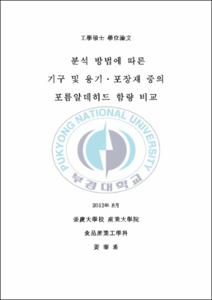분석 방법에 따른 기구 및 용기·포장재 중의 포름알데히드 함량 비교
- Alternative Title
- Comparison of Formaldehyde Contents in Utensils, Container and Packing Materials According to Analysis Methods
- Abstract
- Formaldehyde, classified as a carcinogenic, is primarily known for uses in industrial and medical fields. However, utensils, container and packing materials with daily use such as cups and bowls are also exposed to formaldehyde.
Depending on the purpose, there are many analysis methods. In case of Korean Food Standards Codex, extraction test is notified as formaldehyde analysis method on utensils, container and packing materials.
In this research, it selected the samples of paper, melamine-formaldehyde resin, silicon rubber, urea-formaldehyde resin and starch for the UV-VIS spectrophotometer method which is formaldehyde analysis method using acetylacetone and HPLC method which measures by derivatizing the 2,4-DNPH to find out which of these methods gives more accurate result by comparing and monitoring the test process.
The limit of detection and quantitation of UV-VIS spectrophotometer used in research were 0.035 mg/L and 0.117 mg/L, respectively, and the coefficient of determination (R2) of calibration curve was 0.99970. The limit of detection and quantitation of HPLC-PAD were 0.0018 mg/L and 0.00599 mg/L, respectively. The coefficient of determination (R2) of calibration curve showed 0.999334 meaning that the limit of detection and quantitation, measurement reproducibility and correlation coefficient of the analysis instrument were very superior.
After comparing UV-VIS spectrophotometer method and HPLC method, more accurate result can be obtained by HPLC method.
In addition, HPLC method could detect a very small amount of formaldehyde that UV-VIS spectrophotometer method could not detect.
Based on the research result, it believes that these two methods are proper ways to analyzing formaldehyde on imported or domestic utensils, container and packing materials.
Only if the safety regulations are consolidated accurate result can be expected by HPLC method measuring formaldehyde.
- Issued Date
- 2012
- Awarded Date
- 2012. 8
- Type
- Dissertation
- Publisher
- 부경대학교
- Alternative Author(s)
- Taehee Kang
- Affiliation
- 부경대학교 산업대학원
- Department
- 산업대학원 식품산업공학과
- Advisor
- 김선봉
- Table Of Contents
- 서 론 1
재료 및 방법 4
1. 재료 4
1.1. 재료 구입 4
1.2. 재료의 재질 4
1.2.1. 멜라민수지 4
1.2.2. 요소수지 5
1.2.3. 종이제 또는 가공지제 5
1.2.4. 고무제 5
1.2.5. 전분제 5
2. 분광광도계를 이용한 포름알데히드 분석방법 7
2.1 표준용액 제조 7
2.2. 시약 및 시액 제조 7
2.2.1. 아세틸아세톤 시액 7
2.3. 분광광도계를 이용한 분석방법 7
2.4. 분광광도계를 이용한 포름알데히드 정량방법 9
3. HPLC를 이용한 포름알데히드 분석방법 9
3.1. 표준용액 제조 9
3.2. 시약 및 시액 제조 9
3.2.1. 2,4-디니트로페닐하이드라진(DNPH) 시액 9
3.2.2. 구연산완충액 10
3.3. HPLC를 이용한 분석방법 10
3.4. HPLC 포름알데히드 정량방법 11
3.5. 통계처리 11
결과 및 고찰 16
1. 분석 기기특성 16
1.1. UV-VIS SPECTROPHOTOMETER 16
1.2. HPLC-PAD 18
2. 분광광도계 분석법과 HPLC 분석법의 분석특성 21
2.1. 침출용액에 따른 회수율 평가 21
2.2. 유도체화에 따른 포름알데히드 안정성 평가 22
3. 기구 및 용기·포장재 중의 포름알데히드 분석결과 23
3.1. 종이제 23
3.1.1. 커피 여과지 23
3.1.2. 베이킹 페이퍼 25
3.1.3. 종이컵 27
3.1.4. 종이호일 29
3.1.5. 포장박스 31
3.1.6. 이너패킹페이퍼 33
3.2. 멜라민 수지 35
3.3. 고무제 38
3.4. 요소수지 41
3.5. 전분제 43
4. 포름알데히드 검출량 모니터링 결과 45
요 약 49
참고문헌 53
감사의 글 57
- Degree
- Master
- Files in This Item:
-
-
Download
 분석 방법에 따른 기구 및 용기·포장재 중의 포름알데히드 함량 비교.pdf
기타 데이터 / 1.25 MB / Adobe PDF
분석 방법에 따른 기구 및 용기·포장재 중의 포름알데히드 함량 비교.pdf
기타 데이터 / 1.25 MB / Adobe PDF
-
Items in Repository are protected by copyright, with all rights reserved, unless otherwise indicated.